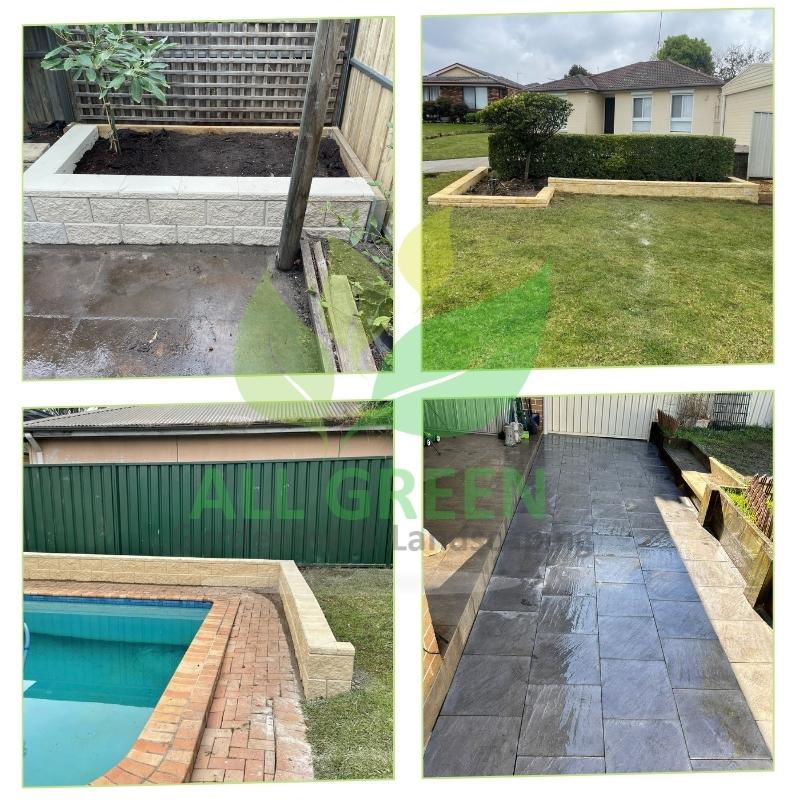All Green Gardening Services: Your Best Choice for Landscaping Parramatta. To begin with, reliability and quality work are what define us. Here at All Green Gardening Services, we prioritise your satisfaction. Consequently, we have a long list of happy customers. Simply put, excellence is just a phone call away.

Looking for a Local Landscaper in Parramatta? 🌱
To discover a local landscaper, “landscaper near me” is the typical search term used. Welcome to us! We focus on landscape garden maintenance, delivering services like retaining walls, outdoor space design, garden planning, and complete landscaping packages.
Parramatta’s Best Landscaping Company Is Here
From major undertakings to minor tasks, our landscape design services are cost-effective and top-grade. In structural landscaping, we offer a comprehensive solution through our expert team.
Our commitment to affordability and local presence is reinforced by our Best Price Guarantee!
All Green Gardening & Landscaping is NSW’s beacon for landscaping perfection. From weeding to paving, we sculpt spaces that captivate and add value. A radiant garden awaits you. Partner with us and let your exteriors speak volumes.
We also serve and have landscaping projects in the following surrounding suburbs:
The Perks of Picking All Green Gardening:
- Full-Service Mastery: From mulching to paving, we are the experts.
- Value Addition: We uplift both the appeal and worth of your property.
- Garden-Centric: Personalized solutions to celebrate your garden’s identity.
- Eco Champions: Upholding green and sustainable methods in every project.
- Landscaping Maestros: Our team promises excellence and precision.
- Customer First: We pledge commitment to your needs and satisfaction.
Parramatta Landscaping Services by All Green Gardening & Landscaping
We’re All Green Gardening and Landscaping, known for our skill in crafting inviting, organic landscapes that enhance the appeal of residential and commercial properties with our expert landscape design. Keep in touch with us on our Facebook Page. For backyard landscaping in Parramatta or more ambitious projects, our commitment remains steadfast: delivering superb customer service and expert Parramatta landscaping solutions. For both residential and commercial needs, we provide a full range of landscaping services, working closely with our proficient designers and installers.
For extensive design projects, our licensed landscape designers will visit to create the finest design for your area. We’ll schedule a site consultation with our designers to delve into your project and determine the necessary tasks. After this, we’ll deliver a comprehensive landscape design consultation for you.
Why Trust All Green Gardening & Landscaping? ⭐
Since 2010, our skilled landscapers have been serving your area, delivering excellence. We stand by our gardening and landscaping services, guaranteeing 100% satisfaction with our work.
Our name is the go-to choice for the Best Landscaper Nearby, all thanks to the exceptional services delivered by our experienced landscapers.
Our Services
Best Turf Laying Solutions in Parramatta
Reap the Environmental Benefits of Turf Laying Services in Parramatta. Did you know that turf helps in soil erosion control? Furthermore, a grassy area improves air quality. With All Green Gardening Services, go green in more ways than one. Contact us today for eco-friendly turf solutions.
Top-Quality Mulching Services: Best in Parramatta, NSW
Step into the world of superior mulching with All Green Gardening & Landscaping. Dedicated to transforming gardens inParramatta, NSW 2150 our mulching services enhance soil health, curb weeds, and lock in moisture. When it’s about quality and care, we’re the name to trust.
Our Paving Parramatta Experts
When it comes to purchasing top-notch pavers in Parramatta, All Green Gardening and Landscaping is your best choice!
Need a Retaining Walls Parramatta Team
For our Parramatta patrons, our focus is on offering top-tier panel and post concrete retaining walls, a pocket-friendly alternative to brick and limestone.
Expert Tree Services inParramatta
Seeking top-tier tree services inParramatta? At All Green Gardening & Landscaping, we pride ourselves on our comprehensive tree care and solutions. From pruning to removal, we ensure the safety and health of your trees. ServingParramatta diligently, we’re your trusted partner for all things arboreal.
Top-Tier Weeding Services in Parramatta
A garden without weeds is a sight to behold. At All Green Gardening & Landscaping, we provide top-notch weeding services in Parramatta, ensuring your plants get the spotlight they deserve. Partner with us for gardens that truly shine.
Best Landscaping Services in Parramatta NSW 2150
Frequently Asked Questions
{We offer a comprehensive range of landscaping services, including garden design, lawn maintenance, tree and shrub care, hardscape construction, irrigation system installation, and more. | From garden design to tree care and irrigation installation, our landscaping services are comprehensive and tailored to your needs.
Our landscaping services are tailored to elevate your property’s visual appeal, resulting in captivating outdoor spaces that boost curb appeal and property value.
We excel in delivering bespoke landscaping solutions, making your outdoor area a reflection of your unique style.
Current Landscaping Jobs in Parramatta
Join our team as a Local Landscaper in Parramatta for immediate job opportunities. Apply via email.
[justified_image_grid row_height=800 height_deviation=0 overlay=off use_timthumb=no disable_cropping=yes flickr_search_text=Parramatta-NSW max_rows=4 flickr_search_sort=popular]

